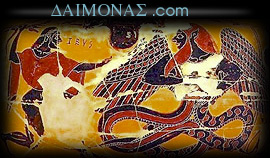|
|
Introductory page:
The Medusa points up and points down.
This
symbolises her function as a protective force over the heavens above
and the heavens which lie below the earth-encircling Ocean Stream
(Hades' Hall);
and is the axis around which the heavens revolve...
She
also doubles, in her pose, as an anthropomorphised swastika marking out
the 4 cardinal points: the extremes of sunrise and sunset during the
winter and summer solstices.
...
|
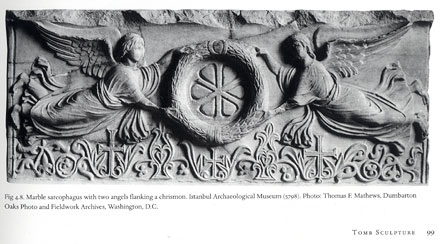
The
"Chrismon" was the symbol of the Greek east used to represent Jesus
Christ. Essentially, the Chrismon evolved from the winged victories of
the Greek (pagan) world. The Chrismon is a symbol of the 4 cardinal
points ("X") which pivot around the world axis ("I").
|
|
The "Chrismon" animation (left). Click button to run the animation.
|

Above:
7th century AD sarcophagus, Ravena. Note the Chrismon is 'guarded' by
the flock represented by the lambs on either side of the cross.
(image source: illus. C, p. 61 The Book of Art. Volume 1. Origin of Western Art, published by Grolier.)

The
Chrismon on the sarcophagus of Archbishop Theodore of Ravena, c. AD
600, with the symbols for the "alpha and the omega": Α - Ω.
The 'polar-aspect' of the Chrismon is in this instance topped with a
crook intended to represent the shepherd's staff. Its similarity to the
Greek letter "RO", r,
has caused some commentators to confuse it with that letter and to
proffer, wrongly, that its appearance on the Chrismon represents the
first two letters of Christ as written in the Greek.
(Image source: image 248, p. 22 Handbook of Art, Graham Hopwood. ISBN 0959927107)
|
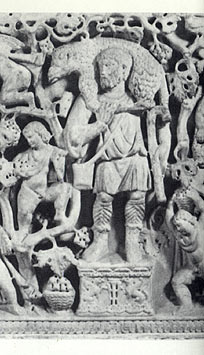
Above:
Late 4th century AD sarcophagus showing Christ as shepherd. The
shepherd's staff, representing the world axis found its way into the
Chrismon. The shepherd's staff came to be adopted as the symbol of
Christian Bishops.
The idea of Christ as shepherd derives from Psalm 23 and John 10.11 and 10.12.
NOTE:
the two griffins guarding the pillar upon which the figure of Christ
stands, intending to emphasise the role of Christ as the world-axis.
(Image source: p. 42 Art of the Western World, ISBN 0671670077, Cole & Gealt)
|
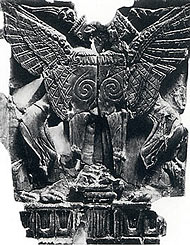
From the "House of Sphinxes", Mycenae, this heraldic sphinx dates to c.1300-1200 BC.
The
word SPHINX in Greek means "constrictor", "tightner", and is familiar
to Anglophones in the word "sphincter". Though the earliest sphinxes
appear in Egypt, they are without wings. The sphinx that arose in the
bronze-age Aegean was winged. The Sphinx guards the void, the source of
wisdom at the apex of the world-axis. That the above heraldic sphinx
represents the world pillar can be seen by the pillar upon which the
front paws of the sphinx rest. The void around which circled 3
circumpolar stars is represented by the absence of the pillar between
the 2 sphinxes facing off. By classical times, when the void
momentarily came to be occupied by a pole star, the pillar was extended
between the sphinxes.
(Image sources: plate 97, p. 114 The Mycenaeans, William Taylour. plate 162, p.133, Minoan and Mycenaean Art, Reynold Higgins.)
|
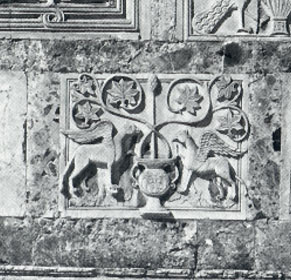
Above, two griffins protect the world tree, on the south wall of St Mark's Cathedral, Venice. This dates to the 12th century AD.
The griffin is first depicted on the frescoes of pre-eruption Thera which date to the 18th - 17th centuries BC.
By
Classical times the griffin had become the guardian beast of the
world-tree/polar-axis and was associated with Apollon.... and thus by
extension, Odin.
It is these same griffins which guard the pillar on which Jesus stands on the sarcophagus depicted higher on the page.
(Image source: plate 22, JJ Norwich A History of Venice, ISBN. 0140066233)
|
A
key feature of Mycenaean religion was the representation of the pillar
flanked/guarded by protector creatures (lions, sphinxes, griffins). It
is conceded now that the "Sea-Peoples" who settled on the Levantine
coast at the end of the bronze age were largely Aegean. The Philistines
were Mycenaean. Recently at Ekron, a Philistine inscription written in
Semitic makes a dedication to "Pythia". The Pythia is the
serpent-oracle at Delphi, Greece. The Pythia was the prophetess whose
powers of prophecy were given to her by Apollon (whose role is
identical to that of Odin). It is in this context that the demand made
by YHWH to the Jews as it is rendered in the Septuagint should be
considered:
"Thou shalt not worship their gods, nor serve them... but shall utterly destroy them... and break to pieces their pillars." Exodus 23.24.
(In
the Bowdlerised Jewish version of the Old Testament, this has been
altered to read "break their sacred stones to pieces" because to later
Jews the idea of "sacred pillars" was meaningless.)
The
Old Testament readily concedes that the peoples who the Jews
encountered in the "promised land" were Aegean: Jeremiah 47.1-4 "This
is the word of the LORD that came to Jeremiah the prophet concerning
the Philistines before Pharaoh attacked Gaza...the day has come to
destroy all the Philistines and to cut off all survivors who could help
Tyre and Sidon. The LORD is about to destroy the Philistines, the
remnant from the coasts of Caphtor [Krete]."
However,
modern 'scholarship' has attempted to reconcile the irreconcilable....
The fictional Moses has been dated to the 15th century BC. This does
not reconcile with the Biblical claim that the Philistines were already
in the "Promised Land" when the Jews arrived. The Philistines only
settled in Gaza at around the 12th century which is attested to in the
inscriptions of Rameses III. This is a full 400 years after the
mythical Moses had entered the Promised Land. To state the obvious:
Moses could not have found Philistines in the promised land at c.1500 -
1400 BC.
The (brief) Moses interlude
In
Exodus 15.14 - as it appears in the Septuagint - YHWH promises the Jews
the land of the Philistines which is rendered Φυλιστιείμ, "Phylistieim"
... In the Bowdlerised Jewish OT the reference to Philistines is
rendered "people of Canaan" instead.
Recent
comparisons of the Dead Sea Scrolls with the Jewish OT and Septuagint,
show that the Septuagint is in greater concordance with the Dead Sea
Scrolls than is the Jewish OT... The provenance of the Greek Septuagint
extends to c. 270 BC; the Jewish OT to c. AD 900. The Jewish version
used in the west has come to include over one thousand years of
after-thought, hindsight and revision.
Aditionally,
the purported Exodus of the Jews from Egypt led by Moses has
increasingly come to be correlated to, and thus dated to, the eruption
of the volcano at Thera, now known to have occurred at 1623 BC. The
pillar by day, flame by night, that it is claimed to have been followed
by the fleeing Israelites in Exodus, has been seen to be the
erupting volcano there. The date of the eruption however predates the
the Mycenaean civilization of Greece; no Mycenaeans = no Sea-People =
no Philistines.
The Moses story is less credible still: "Moses" is no more (or less) than the Egyptian "meses"; "born of/from", eg: Rameses means "born of" Ra, (Sun). The epithet "born of/from" can be found in other Egyptian names: Ahmose, Tothmoses
(Thutmose), etc. The Biblical "Moses" then is no more than an amalgam
of various Egyptian kings whose names end with the epithet "meses". The
etymology profferred in Exodus 2.10, in which it is claimed that it
means "he who was drawn (from water)" is entirely without foundation...
And, as if the Moses story had not already been exposed as a complete
fraud, the story of Moses' beginings, in the form of the tale of his
being found floating down the river in a basket is instead the tale of
Sargon; another leader in another part of the world. Moses is a amalgam
of Egyptian as well as Babylonian rulers. The story of Moses leading
his people out of captivity is utter invention. There is no history in
the tale. [ for an alternate view on Moses: EJ deMeester ]
|
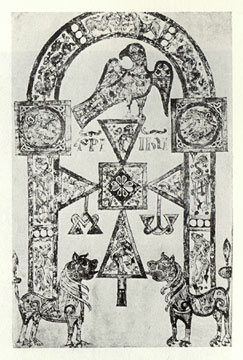
Dated to c. AD 750, this is a page from an illuminated copy of Augustine's Questiones in Heptateuchon. Paris National Library.
The
cross here is clearly the Norse Ygdrassil, on which perched on top is
the symbol of Thor, the eagle. The stylised 'dogs' appear to be an
attempt at emulating the guardian-lions depicted in Byzantine works, as
is evidence by their mane of three forward-flowing locks.
The concept of the lion made a massive impression on the people to the north of Europe.
(Image source: fig. 9 Renaissance and Renascences in Western Art, Erwin Panofsky, ISBN0064300269)
|

Dated to c. 750 AD, an illustrated page from the Galasian Sacrimentary, Vatican Apostolic Library.
That
this is a representation of the cross as world tree is undeniable. Note
the birds perched on it. This is no mere attempt at visual decor.
(Image source: illus C, p. 92 The Book of Art. Volume 1. Origin of Western Art, published by Grolier. ISBN 0671670077)
In
the Norse tale of Sigurd the dragon slayer, the hero Sigurd tastes the
blood of the dragon Fafnir's heart after he kills him and finds that he
has acquired the power to understand the speech of birds. The prophetic
nature of birds was central to German and Greek beliefs.
There is no such bird lore in Jewish tradition. To proffer what Josephus wrote on the matter as he ridicules the Greeks:
"...
on the march towards the Red Sea ... was one [Jew] named
Mosollamus...the whole force was being held up by a seer who was taking
the auspices, [Mosollamus] inquired why they were halting. The seer
pointed out to him the bird he was observing, and told him that if it
stayed in that spot it was expedient for them all to halt; if it
stirred and flew forward, to advance; if backward, then to retire. The
Jew without saying a word drew his bow, shot and struck the bird and
killed it. The seer and some others were indignant... [Mosollamus
responded] 'Pray, how could any sound information about our march be
given by this creature, which could not provide for its own safety? Had
it been gifted with divination, it would not have come to this spot for
fear of being killed by an arrow of Mosollamus the Jew."
Josephus Contra Apion. 1.201-204, Loeb translation H St J Thackeray.
|
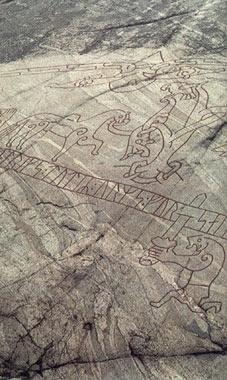
Above:
Detail of rock carving at Ramsund, Sodermanland, Sweden. This Viking
petroglyph shows the hero Sigurd stabbing the dragon Fafnir. In the
centre is depicted Ygdrassil, the world-tree, upon which are perched
birds. Birds were symbols of prophetic wisdom and it was their speech
which Sigurd now came to understand.
Note
the similarity of the stylisation of the birds with those found at the
Sutton Hoo ship-burial mound (right) and the illuminated Vatican
manuscript (above). This idea of the Indo-European world-tree was
syncretised by the Vikings (as it had been syncretised earlier by the
Germans and earlier still by the Greeks), with the cross.
(Image source:p.p. 154-155 The Viking World, James Graham-Campbell. ISBN 0906459044)
|
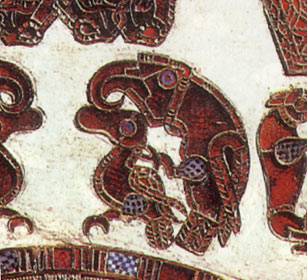
Above: Detail of one of the birds on the purse lid from the Sutton Hoo burial-ship mound, Suffolk England, c. AD 650.
|
The
world tree represents an idea which was never quite understood by the
Judaic faith. After-all, their god demands that they destroy utterly
the altars of those who held alternate beliefs and worshipped
alternative gods. As such the tree was alien to their traditions. The
earliest mention of the worship of the world tree can be found in
Sumerian inscriptions dating to the 18th century BC. It was a foreign
'abomination' which Gilgamesh (in the Sumerian version) set out to
excise and so purify the land desecrated by its presence[ re: snake worship ]. Josephus quotes Hecataeus' observations of early Jerusalem:
"Nearly
at the centre of the city [of Jerusalem] stands a stone wall, enclosing
an area...[which] is approached by a pair of gates. Within this
enclosure is a square altar... Beside it stands a great edifice,
containing an altar and lampstand... There is not a single statue or votive offering, no trace of a plant in the form of a sacred grove or the like." Josephus Contra Apion I.198-199. Loeb translation H St J Thackeray.
For Josephus this is an observation of Jewish piety. It is a piety however in which the tree is utterly absent.
Although
Judaism was ignorant of the significance of the world tree, all the
Indo-Europeans newly converted the Christian religion understood the
symbolism. This understanding of the symbolism of world tree lingered
for a considerable period of time. To understand the world tree that an
intolerant YHWH demands be destroyed one has to look at traditions
outside the Levant.
|
|
Left:Detail of the fresco Last Supper with the Tree of Life, c.1360, Taddeo Gaddi Refectory Florence.
Here Jesus' association with the world tree-cum-polar-axis is made explicitly clear.
|
In this way then, Jesus is the controller, and the "Chrismon" also doubles as the double-trident/world tree of Zeus.
Equating the association of the world tree and Jesus with Odin and Yggdrasil.
|
|
Below left: Panel
from the Thorwald Cross, Isle of Man. On this 10th-century Manx stone
is a depiction of Odin. Note the stylised world-tree which has, at its
apex, the swastika-cum-cross.
|
JUDAIC MISINFORMATION FROM:
http://www.shoaheducation.com/thor.html
"Wotan,
in Norse Mythology was a warrior sovereign, and is often seen as the
primary god. The Nazis used the archetype of Wotan because of his
"Warrior-King" traits, but many of even the top ranking officials
believed in the Mythological character as more than merely Archetype.
Josef Goebbels, in his conference notes once made the remark regarding
what was to be let known about the Nazi agenda for the post-war period,
said, "We will of course not let them know about Wotan. (Woden)". More
remarkably, Wotan, or Odin, was rumored to have hung himself on a tree
to obtain knowledge which was granted him, and gave his victory in
doing so gave him the ability to travel freely in the nether-worlds
(like hell) or in the heavens. The Nazis at the highest level intended
after Europe was in their control, to assimilate the Church, and
re-interpret such central doctrines as Christ's crucifixtion[sic] and
victory over death, with the keys to Heaven and Hell in terms of old
Norse Legend, or as it was referred to as 'volkish mysticism'. Wotan or
Odin is also said to have learned runes in this way, which fascinated
the Nazis.(the swastika is an example of a rune).1 © 2003
Elizabeth Kirkley Best PhD; Shoah Education Project (Web)"
Commentary on the PROPAGANDA quoted above: The tale of Odin suspended from Yggdrasil occurs in the Havamal (The Sayings of Har), stanza 138, of the Poetic Edda.
It is not a matter of "rumor", imbued with the implication that it was
a Nazi concoction. The purpose of Odin's quest was the search for
wisdom. This wisdom was from the void of the polar axis. There is no
such place in Norse Mythology that might be termed "Hell" as it exists
in the Judaic/Christian sense of the term. The Underworld was known as
the Hall of the goddess Hel. Odin controlled the seeresses of the
underworld, in the identical way that Apollon controlled the Greek
prophetic forces of the underworld and the seeresses, for instance the
Pythia (the oracle) at Delphi. Indeed, the chasm which mesmerised the
Pythia was the polar void... the same pillar-cum-world-tree whence
Odin's knowledge sprang. Finally, the swastika is not an example of a
rune!
|
|
Medusa, megaliths, the world tree and the "New World"

Image source: illus 23 ART OF THE ANDES from Chavin to Inca, by Rebecca Stone-Miller. ISBN:0500203636.
|
There
are many motifs which though originating in the "Old World" appear
fully formed in the "New World". The "Lanzon" (left) is a cult image of
the Chavin culture of Peru and dates to around 400 BC (though it is
sometimes dated earlier). The similarity of the head of the "Lanzon"
with the head of the Medusa, though unmistakable is usually attributed
to "coincidence"... including the evolution of snake-heads from
spirals, a design that is of Balkan origin.
The
so-called "coincidences" do not end with the head. Like the Medusa, the
"Lanzon" is also a polar protector: one hand points up and the other
down. Like the Medusa whose pose forms an anthropomorphised swastika
symbolising the 4 cardinal points, the Lanzon, "...was
located in a cruciform gallery deep in the center of the temple.
Representing the four directions and sacralizing the spot as a world
center..." p. 35.
The
Lanzon thus not merely appears similar to the Medusa, but fulfills her
function as a world-pole protector and marker of the 4 cardinal points.
[The "Lanzon", according to the Wikipedia]
The "Lanzon" however is not an isolated occurrence in the Americas.
[The farce of Sitchin
There
is at present an author, for whom reality is an unnecessary impost
which serves one purpose alone: to prevent the acceptance of the
fantasy he propounds from being accepted as truth... I am referring to
Zecharia Sitchin.
Sitchin has an altogether different explanation for the "Lanzon". According to him, in The Lost Realms, p. 188:
"The
image on this monolith has been the subject of much speculation; to our
eyes, again, it seems to depict an anthropomorphized face of a bull."
(!)
Sitchin
proposes an extraterrestrially-derived basis for all of the world's
civilizations...in which extraterrestrials imparted wisdom to his
people... Semites... which ultimately forms the basis of the Old
Testament.]
|
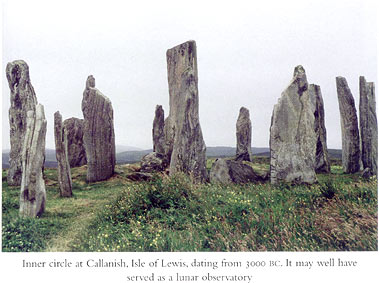
Above image Source: Europe's Lost Civilization,
Marshall (a book I do not recommend). European megaliths appeared along
the Atlantic coast of Europe. The one above is from the Isle of Lewis
and dates to 3000 BC.
|

Above image Source: internet:
"'Brazilian Stonehenge' discovered By Steve Kingstone BBC News, Sao Paulo
"
Brazilian archaeologists have found an ancient stone structure in a
remote corner of the Amazon that may cast new light on the region's
past. The site, thought to be an observatory or place of worship,
pre-dates European colonisation and is said to suggest a sophisticated
knowledge of astronomy. The archaeologists made the discovery in the
state of Amapa, in the far north of Brazil. A total of 127 large blocks
of stone were found driven into the ground on top of a hill. The layout
suggests a temple or an observatory .It is not yet known when the
structure was built, but fragments of indigenous pottery found at the
site are thought to be 2,000 years old."http://news.bbc.co.uk/2/hi/americas/4767717.stm
The
structures found in Brazil in 2006 are remarkably, and again
"coincidentally", like those of the European Atlantic seaboard
megaliths, particularly those at Carnac.
|
|
|
Image source: Fig. 2:13, p. 78, Maya Cosmos, Friedel, Schele, Parker. ISBN:0688140696
"Coincidentally"
(again) The Maya worshipped the World Tree. At its apex presides the
bird (Seven-Macaw). The ecliptic of the world is symbolised by a
serpent. One recalls the eagle of Thor/Zeus at the apex of the world
tree (which can be equated with the Macaw); and the ecliptic Midgard
Serpent/Hydra/Ophion of the Germans and Greeks respectively.
The Maya ecliptic serpent though, unlike the Greek and Germanic serpent is double-headed. One is reminded however of the Theran Mariner's double-headed serpent... [ refer snake page ] which dates to before 1600 BC.
The
Maya worshipped the symbol of the world Tree as a cross, this "allowed
[the Maya] to embrace the outward forms of Catholicism without losing
the cosmological content of their own beliefs.." David Freidel (above
publication).
|
Ideas
originating in the Old World eventually found their expression in the
New, since the time of the megaliths (and most likely earlier).
Eventually these ideas came to include Greek elements. What is the
gorgon-face doing at the base of a Maya representation of the
world-tree?
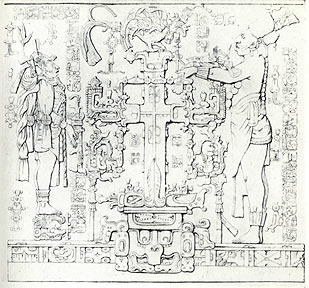
The "Cross of Palenque", Mayan relief, Yucatan, Mexico.
(Image source: Plate XLI a, Symbols of Transformation, Carl Jung. ISBN 0691018154)
The Medusa swastika pose persists in contemporary culture, and can be found in the "magician" Tarot-card.
That
these are the same elements can be seen in the symbols used: the wand
is the polar axis; the hands pointing to the heavens above & below
fulfill the swastika element of the medusa whilst pointing to the
figure as protector of the polar axis. Though it might be obscure to
many, the eternity symbol (sideways figure-eight) is a symbol of the
eternal sun-path, and the pentagon with its five points symbolises the
5 planets visible to the unaided eye.
©
The images on this page are © of the various publications. They
have been presented on this page on the understanding of "fair use".
|
